These are the pictures and videos taken inside the NHCP Museum of Philippine Maritime History last June 15, 2025 at around 11:00 am.
The blog offers a breezy invite to my hometown and my birthplace. In this blog, you will learn the story of the place where I have been raised and molded into the man that I am today. Prepare as well your backpack as we embark on a never-ending journey to some of the world’s most exciting destinations – places around the world I wanted to visit. ENJOY READING MY BLOG!
Showing posts with label Philippine History. Show all posts
Showing posts with label Philippine History. Show all posts
Sunday, July 13, 2025
Inside the NHCP Museum of Philippine Maritime History
Labels/Tags:
History,
Museum,
Philippine History
Location:
Iloilo City, Iloilo, Philippines
Subscribe to:
Comments (Atom)










































































































































































